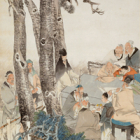Asian Gallery (Toyokan) Room 8
November 17, 2020 (Tue) - December 23, 2020 (Wed)
After the Opium War (1840–42), the Taiping Rebellion (1851–64), and wars with major powers, a revolution led to the establishment of the Republic of China in 1912. In Shanghai, the port was opened for international trade from the treaty of Nanjing (1842).
Trade and the establishment of American, British, and French settlements led to rapid modernization and an influx of Western technology, culture and ideas. While prosperous cities such as Nanjing, Suzhou and Yangzhou fell into turmoil in the Taiping Rebellion, the wealthy moved to Shanghai to take advantage of its economic development and security.
The concentration of wealth lured many artists to the city, and led to the establishment of art societies and schools, making Shanghai a center for art and culture. Artists known for their plain subjects in bold brushwork active in this period of rapid modernization are known as the Shanghai School.

